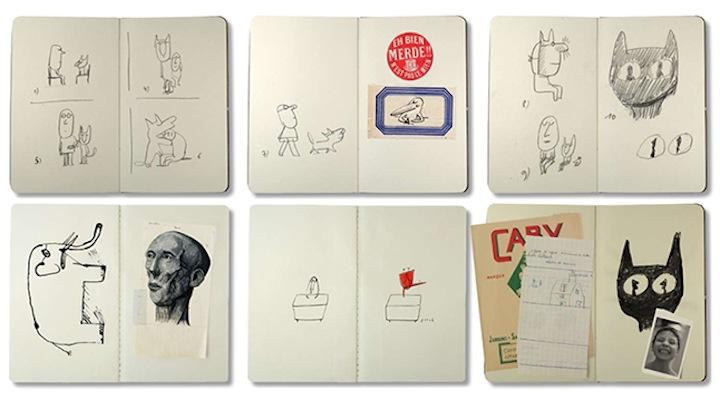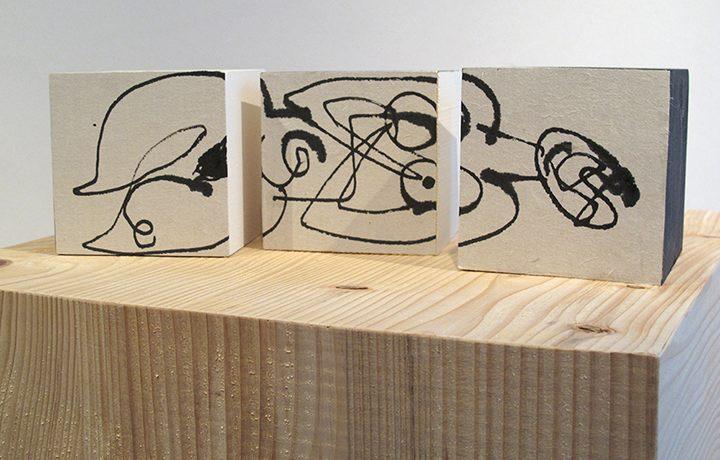Serge Bloch: The Q&A
If your day is off to a bad start, just go to Serge Bloch’s website; you should feel better right away. For now:
Q: As an artist, what are some of your favorite things about living and working in Paris and New York
A: I was born in Colmar, in Alsace, on the border between Germany and France. I like Paris and New York; I like cities in general, they make it easy to meet people, and I like people. All loners do. NY and Paris are different cities, the people are different, and they have different cultures and histories. I like to break out of the everyday, and changing locales lets me do that; after all, one has the freedom to work from anywhere now…
How and when did you first become interested in art and illustration ?
I studied at the Ecole des Arts Décoratifs de Strasbourg. I was Claude Lapointe’s student, a famous illustrator who helped me discover the field. After that, I started an ad agency with a friend, and then ended up being hired as Art Director in a children’s publishing house. I was also drawing the whole time; I illustrated books and newspapers (among other things) printed in France and in the US, as well as other countries like Germany, Japan, Korea…
What was your first commercial assignment?
I drew a front-page illustration for the Strasbourg daily when I was still a student.
What is your favorite part of the creative process?
I like researching an idea and having it materialize, but I especially enjoy being done with a project!
Do you keep a sketchbook? What is the balance between art you create on paper versus in the computer?
I do use a sketchbook to jot down ideas and write down storylines; for years, I also used it to draw and goof around with my sons when we were waiting for food at restaurants.
When it comes to computers in comparison to paper, I like paper, and making illustrations for exhibits; being able to touch it, and to respect it, since paper is alive. Using it, I can find the honesty in a pencil stroke, or truth within colors, or collages.
Computers are creative tools. I am not a digital native, and I remember a world without computers. I also remember starting to use computers, the stress I felt seeing the little bomb icon or having the computer crash and having to start over again from scratch. I’ve mastered it now (or maybe it’s the other way around), but I try and stay modest, especially when I see how adept my students are at using digital technology. Computers also allow us to work quickly and in real time anywhere in the world; every tool one can use has its own logic and specific uses. Whether one uses a nib, a brush, bamboo, or a computer, the point is to utilize each tool’s specific strengths.
How do you spend the first hour of your work day? What is your favorite time of day for working?
I start the day by reading emails, sometimes working on projects I forgot to finish the day before and have to send out quickly. Otherwise, I procrastinate, not for too long though…
When I was younger I could work just as well at night
as during the day. Nowadays, I’m asleep at night and work during the day, that is if I’m not napping.
The best time for work, in any case, is when you have an idea, night or day!
What are you listening to? What are you reading?
I listen to all types of music, from all parts of the world: classical, modern, electronic… I’m often reading literature that is somehow related to my travels, whether I’m going to China, to the US, etc.
Who and what are some of your strongest influences?
Masters of the line, or stroke: Paul Klee, Steinberg, Steig, Topor, Blechman, Sempé, Ben Sann, Bosc, Chaval, André François and many more… My tastes run a fairly wide gamut, from Calder to Charles Addams.
Did your participation in the AI32 LIVE Cover Project have any spillover into your studio practice? Do you recommend marathon art projects for inspiration or redirection?
Participating in the AI32 LIVE Cover Project was a real pleasure, a truly pleasant day spent working with artists I already knew or whose work I discovered then and there. I love this kind of challenge, one that forces you to step ouf of your comfort zone and forget the outside world so as to focus in an unfamiliar place. Would do it again and again !
What was the last art exhibition you saw and what did you take away from it?
An exhibit in Paris showing photographs by Vivian Maier. Her work, as I discovered, is modest, sensitive and beautiful.She casts a unique glance on the city and its people; she’s very adept at mirror effects, to say nothing of her self-portraits, some of which almost seem like images stolen by her camera. Her work is also important for what it has to say regarding fame as opposed to obscurity, especially considering the fact that she developed a very small amount of the pictures she took. Her need to create despite meager means and continue doing what she loved also reveals the paradox present in all arts.
Have you ever had a creative block with a deadline looming? What do you do to get crackin’?
I don’t get blocked. When I run out of ideas, I fake it, but don’t tell anyone, it’s a secret.
Is there any particular new technology you’ve embraced as an avenue towards entrepreneurial adventures?
The Internet: it’s allowed me to work across oceans. No more boundaries.
Digital photography and Photoshop, as well. It gives you this immense freedom, it’s almost scary to
have that much power at your disposal. You can make images move,
or even add sound. Quite a revolution for those of us born to paper’s silence (a heavenly silence!)
Where do you teach—and what do you like best about teaching?
I teach at the Ecole des Arts Décoratifs de Paris. I’m new at it, and feel like a beginner. What I like best is to meet young people trying to find something.
What advice would you give to a young illustrator who is just getting noticed?
Keep your wits about you, avoid fads, work with long-term goals in mind, always stay curious and seek pleasure. P
leasure is what fuels it all, without taking any for yourself how can you give it to others?
Serge Bloch has illustrated more than 300 books; his editorial illustrations appear regularly in The New York Times, The Wall Street Journal, Time Magazine, The Los Angeles Times, as well as GQ and National Geographic, and two of his books have been turned into animated series. Bloch's works have been exhibited in New York, Los Angeles, France and Italy. Bloch has received awards for his artwork and illustrations from around the world, including a Gold Medal from the Society of Illustrators, the Prix Baobab, the Bologna Ragazzi Award and the Best Book Award in Taiwan.


